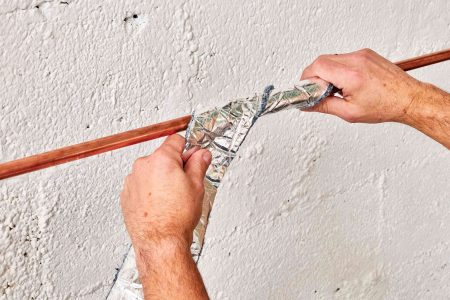Of all home improvement projects, none is more complicated or expensive than the steps to building an addition to a house. Building a full room addition changes the home’s actual floor plan by digging and installing foundations, then framing and finishing a new living space. The National Association of Realtors points out that building an addition to a house can cost as much as $90,000 to triple that depending on the size and purpose of the room. In some cases, this could be as much as or more than the original cost of the home. Though there isn’t a calculator that estimates what building an addition costs, you’ll need to call and compare quotes from various contractors. Despite the enormous scope and cost of such a project, room additions are highly prized, since no other project has such potential for improving the livability and real estate value of your home.
Though it’s possible to build an addition onto a house yourself, it’s very rare for a homeowner to tackle this kind of work. This type of project is virtually always a job for a general contractor and/or a variety of subcontractors. The skills required to complete a room addition include a very broad range of abilities, and almost no one—even a skilled tradesperson—can do it all themselves.
That doesn’t mean, however, that the owners are hands-off. On the contrary, homeowners need to be involved with every step of the process to make informed decisions and ensure the work meets their expectations. If you accept the challenge of managing the project yourself, understanding the steps to adding onto a house will help you schedule and supervise the work of all the various subcontractors who will work on your project. And as a homeowner, you may choose to tackle certain aspects of the overall project yourself, such as doing the final finish carpentry work or painting the walls.
Whatever your degree of participation, it helps to view the work as a single large step-by-step project to understand how contractors work and to effectively evaluate and supervise their activity and plan your own involvement.
Before You Begin
Specific building materials and the tools required to work with them vary from project to project, but as a general rule, home additions include most (if not all) of the same elements that building a new house requires. There can be dozens of materials and tools used in constructing a major room addition, ranging from major excavation equipment and concrete tools to the stains and varnishes used to put finishing touches on woodwork and cabinetry.
Few building trade professionals own all the tools or have all the skills required to complete a major room addition, so it is very common for the work to be supervised by a general contractor (GC) who will bid on your job, then supervise and pay various specialist subcontractors to complete the project to the agreed-upon specifications. While it’s possible to plan a project yourself, hiring and supervising the subcontractors on your own is a daunting task that many homeowners end up regretting. Your room addition will probably go together much more smoothly if you hire a general contractor.
Be prepared for the fact that it takes a long time to build an addition to a house. While the actual labor time may take only two to four weeks of eight-hour workdays in the hands of skilled contractors, there is typically a lot of downtime between phases as the project awaits the arrival of inspectors or the next subcontractor. It’s not uncommon for a major room addition begun in late spring to reach its completion sometime in the fall. The time required is largely dependent on the availability of labor and materials in your area.
What You’ll Need
Equipment / Tools
- Foundation tools
- Framing carpentry tools
- Roofing tools
- Finish carpentry tools
- Plumbing tools
- Wiring tools
- HVAC tools
Materials
- Foundation materials
- Framing lumber
- Floor, wall, and roof sheathing
- Various fasteners
- Plumbing materials and fixtures
- Electrical materials and equipment
- HVAC system components
- Windows and doors
- Interior floor, wall, and ceiling finishes
- Cabinets or other built-ins
- Exterior siding and trim
- Roofing and gutters
- Paint and other finish materials
Instructions
Steps To Building an Addition to a House
-
Determine the Budget and Scope
Successful room addition projects begin with a considerable amount of research and a precise determination of the size and scale of the work. A home addition is just like building a house and it involves designing, budgeting, applying for permits, hiring contractors and subcontractors, and building the structure from the ground up.
- It’s important to be prepared for the work involved and to be realistic about your budget. While some homeowners report paying $50,000 to $75,000 for a full-scale, multi-room house addition, a more realistic number is probably in the low six figures. For example, expect to pay roughly around $150,000 to $250,000 to add 1,000 square feet to a house, depending on costs in your area.
-
Secure Funding
Few homeowners can pay for a full room addition in cash. Thus, a loan or line of credit is needed. This usually involves obtaining a home equity loan, second mortgage, or line of credit based on the amount of equity in the home—the current real estate value of the home minus any outstanding mortgage or loan balance.
Banks and other lenders are often reluctant to loan money to homeowners who still owe 80-85 percent or more of a home’s assessed value, though this is not a hard and fast rule.
Where a homeowner does qualify for a second mortgage or home equity loan, banks will normally extend no more than about 85 percent of whatever equity you have in the home. For example, if your home is assessed at $500,000 and your remaining balance on the mortgage is $250,000, many banks will be willing to loan you an additional $212,000 (85 percent of $250,000) to complete a major room addition, if it promises to add a good amount of value to your home. Securing a loan is, of course, dependent on a homeowner that has good credit standing.
If you can’t qualify for a bank loan, there are other ways to secure loan financing, such as borrowing against the value of a retirement fund or life insurance policy. Such borrowing should be done carefully, though, after consultation with a financial advisor.
-
Select a General Contractor
Most people will find it best to hire a general contractor (GC) to complete the work on a room addition. The GC may have a salaried staff of general carpenters that perform much of the work, but they also work with a variety of specialty subcontractors who will be hired for specific duties, such as plumbing, wiring, and HVAC work. You will pay the GC directly in agreed-upon installments for the project, and the GC will in turn pay and supervise his own employees and the various subcontractors that work on your project.
Everything hinges on the ability to find a reputable contractor who you can work with, so take your time picking the GC. Get recommendations from neighbors, friends, or relatives. If they cannot recommend a contractor, lose your shyness and knock on the doors of homes that have recently had additions completed.
The importance of the contractor cannot be overestimated. For most people, this job is too big for you to manage on your own unless you have professional experience and ample time. Your first meeting with prospective contractors should discuss the scale of the project, the contractor’s timeframe, general design issues, and cost-saving strategies.
Don’t be afraid to ask the contractor about options for controlling costs during the early planning process. The GC’s profit on your project is typically 10 to 20 percent of the total bid, so you have a right to negotiate assertively. This is the time when you might agree to tackle some of the finish work yourself in exchange for a discounted bid.
You and the general contractor should sign a contractual agreement before work begins, including a schedule for making payments. There is no hard-and-fast rule on how payments should be scheduled. It’s often regarded as a warning sign when a general contractor insists on more than 50 percent of the total as an upfront downpayment. In fact, laws in some areas prohibit contractors from asking for a down payment of more than 1/3 of the total contract. A contractor who wants the majority of the payment upfront may be on shaky ground financially.
More commonly, payment is made in two or three equal installments, keyed to important completion milestones. But it’s important that you’re allowed to withhold a significant fee (10 to 25 percent) until you make a final walkthrough of the project to verify your satisfaction.
-
Work With an Architect (Where Appropriate)
While some contractors can design your addition or can work from stock building plans, in many cases it’s best to hire an architect. There is some value in going with an architect recommended by the contractor, as this ensures both parties are familiar with one another. However, if you’re considering this arrangement, make sure to perform due diligence and make sure the architect is qualified—not just a friend of the GC.
When searching for a contractor, you may see the term design-build contractor used. Design-build contractors have been around for many years and are commonplace. A design-build contractor is, in basic terms, the same as a building contractor, but one who forgoes the use of an architectural company. The design-build contractor doesn’t necessarily employ an architect but instead may rely on an in-house designer to create the plans.
Though design-build contractors advertise themselves as one-stop shops, there are pros and cons to hiring this type of contractor. Some design-build contractors are extremely competent, while others can be shoddy. If you’re considering hiring a design-build contractor, carefully research their past work for several clients.
-
Obtain Permits and Prepare the Site
Your contractor will obtain permits and will be required to post the approved permits in a visible spot on your property. A crew will come and drop off a portable toilet, and perhaps put up an advertising sign identifying to the world the company that is building your addition.
To prepare the site, large earthmoving equipment may arrive to strip the site to level, bare dirt. Obstructions will be removed—perhaps even some trees (if permitted by your community). Fences will be temporarily taken down to allow heavy equipment to access the site.
Don’t fret about this seemingly extreme change to your property. This kind of earthmoving will make the construction go more smoothly, and the final steps usually involve additional earthmoving and contouring to restore the landscape to a finished appearance.
-
Build the Foundation
Most room additions get a full-scale foundation, just like a new house. Depending on the plans, the crew will begin pouring a concrete slab or excavating for a crawlspace or basement, followed by pouring concrete footers and foundation walls.
Foundation work is generally done by a specialist contractor hired by the general contractor—often the same crew who performs the early preparation of the site. It can take several days of digging, pouring, and curing the foundation before it’s ready for the framing crew to begin work.
-
Frame the Structure
As soon as the foundation concrete is cured, the floors, walls, and roof are framed. This can happen with surprising speed when a large, experienced crew does the work. One day, you come home from work and find that the entire skeleton of framing members has appeared.
Some projects are “stick-built,” with the framing crew building the floor platforms, the stud walls, and the roof rafters piece by piece before sheathing them. In other cases, certain elements are built off-site, then trucked in to erect in large pieces. It is now common, for example, for roof trusses to be built off-site, then hoisted into place by a crane. In other cases, though, even the framed walls are manufactured off-site, which can make the structural framing go quite fast.
The structural framing is often done by a crew of carpenters that work permanently on staff for the general contractor, but it’s also common for carpenters to be independent workers hired on an as-needed basis.
Framing happens quite quickly, often within a day or two, since there is an urgent need to get the structure sheathed to shelter it from the weather.
-
Add the Sheathing and Roofing
Wall and roof sheathing, followed by house wrap, roofing paper, and shingles, quickly follow the framing work. The goal is to give the structure a good measure of weather-proofing and allow crews to continue their work under shelter. The wall and roof sheathing are usually installed by the same crew that does the basic framing, though shingles and other roofing materials are often done by a specialist subcontractor.
In today’s construction, walls are usually sheathed with OSB (Oriented Strand Board) panels and then covered with a fiberglass film known as house wrap. For the roof decking, it is more common to use plywood panels, though OSB and other materials are sometimes used.
The roof is almost immediately covered with shingles or another finish roofing material. This, along with the installation of the windows and doors, protects the structure from rain and allows the interior work to be completed in a more leisurely fashion.
As the roofing is completed, the project appears to be moving ahead at a fast pace, though what follows often takes quite a bit of time.
-
Install Windows and Doors
New windows and doors are installed just after the roof—or sometimes concurrently. This buttons up the structure and keeps it weathertight for subsequent work. Construction pros describe the building as being “dried-in” after this stage, meaning the interior is protected from the elements.
Windows and doors for room addition are usually stock elements ordered from the manufacturer. They are easily installed by the general carpenters.
-
Rough-In the Electrical, Plumbing, and HVAC
Crucial services, like electrical, plumbing, and heating/cooling are “roughed-in,” meaning the behind-the-scenes elements like pipes, wiring, and ductwork are installed while the walls, floors, and ceilings are still in their raw framed condition, with the framing members exposed.
It is normal for the project to appear to slow down when these subcontractors—the electricians, plumbers, and HVAC technicians—come in, but these trades tend to work fairly rapidly, often completing their work in a day or two. The real snags tend to be associated with waiting for city inspectors to inspect and approve the work. These systems need to be inspected and approved before any additional work can be done on the walls, floors, and ceilings.
-
Add Insulation and Drywall
With the addition of insulation and drywall after mechanical inspections are complete, the project is beginning to look like a real structure. Insulation may be one or more of many different types, from standard fiberglass batts to sprayed foam to blown-in cellulose. Drywalling is a multi-stage process: hanging the sheets, “mudding” the seams with wet drywall compound, letting that compound dry, and then sanding the seams.
Insulation and drywall are sometimes installed by the general framing carpenters, but it can also be done by subcontractors who specialize in this work. If they work steadily, workers will complete the insulation and drywall installation in just a couple of days.
-
Finish the Interior
The next step is for the flooring and cabinetry to be installed, and for the ceilings and walls to be painted. Either task can come first, and the order is often dictated by schedule availability. Painting contractors are experienced at painting cleanly after the finish flooring has been installed, but trim work is easier to install after the walls are painted. With small projects, painting and flooring are often completed by finish carpenters, though large jobs may call for flooring and painting subcontractors.
Installation of interior passage doors, baseboards, window trim, door trim, crown moldings, and other trim is normally done by finish carpenters who specialize in this work, though some general carpenters are equally skilled at rough framing and finish work.
-
Make Fixture Connections
Near the end of the project, plumbers, electricians, and HVAC technicians will return to complete the installation and final hookups for plumbing fixtures, light fixtures, wall switches, outlets, and HVAC equipment. Some of this work may be done simultaneously with the interior finishing work.
Delays are common at this stage, as these mechanical system subcontractors are in fierce demand. Many local building codes require licensed subcontractors to perform this work but if allowed, the general contractor may have their own employees complete much of the final connection work.
-
Complete the Landscaping
As the interior of the home is nearing completion, the landscape that was uprooted to allow for easy access to the site is now repaired. Earthmoving equipment may return to backfill around the foundation, level and contour the yard, and landscaping contractors may arrive to plant trees and shrubs and restore the lawn.
While the earthmoving work is often under the general contractor’s supervision, homeowners sometimes contract with a different firm to do the final landscaping work. Or, some homeowners choose to do planting and lawn restoration themselves.
-
Complete the Punch List
A punch list is a record of the miscellaneous items left to be done. Many of these are finishing touches that had to wait for other work or were simply missed in the process. Often, both the contractor and the homeowners compile their own lists and combine them into a master checklist.
Completion of the punch list and a final walkthrough by the general contractor and homeowner is the last step, and it marks the point where the contractor now invoices the homeowner for the final payment.
There are many ways to structure the payment schedule from the homeowner to the general contractor, but it is typical for there to be a substantial downpayment upfront, before work begins, followed by one or two payments made at agreed-upon intervals as the work progresses. It is typical for at least the last 10 percent of the payment or more if parties agree to be contingent on the completion of the punch list and the final walkthrough by the homeowner and contractor.
-
What should I know before adding an addition to my house?
The first step to building an addition, even before contacting contractors, is to weigh the pros and cons of the project by finding out the answers to two questions. Will your type of addition add value to your house? Though you may not have plans to sell your house for a long time, any addition can impact the appraisal, resale value, and return on investment in the future. And are there any zoning restrictions that will alter your addition plans? Your town may not favor building up, but your property lines may not allow you to build out, for example.
-
Is it cheaper to build up or out for an addition?
Building up is usually cheaper than building out. Building up requires framing materials plus labor. Building out, unless it’s a bump-out, requires materials and labor for digging, foundation work, and landscaping. The cheapest way to add an addition to a house is to finish the basement, attic, or garage because you will bypass all the costs of adding a foundation or roofing.
-
Do I need blueprints for an addition?
Yes. You will need a blueprint, or a floorplan, drawn up to guide the project and also to get a building permit from your town’s building department.
Read the full article here









